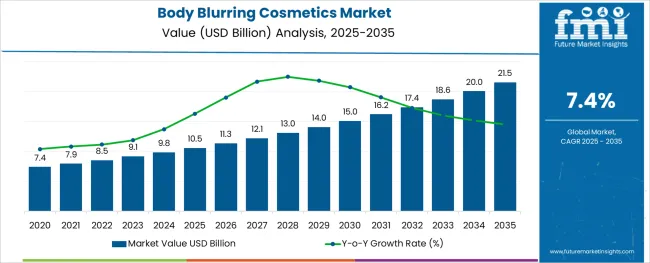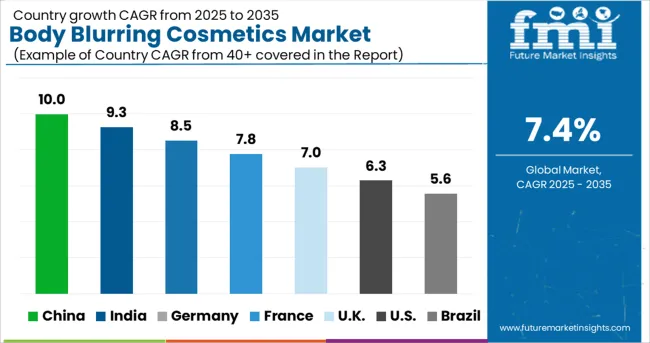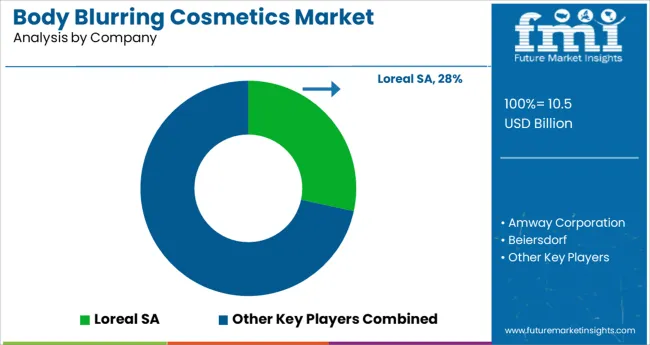The Body Blurring Cosmetics Market is estimated to be valued at USD 10.5 billion in 2025 and is projected to reach USD 21.5 billion by 2035, registering a compound annual growth rate (CAGR) of 7.4% over the forecast period.

The alginic acid market is undergoing consistent growth, propelled by rising demand from food processing, pharmaceutical formulations, and cosmetic applications. A growing focus on natural and sustainable ingredients in manufacturing processes has positioned alginic acid as a preferred biopolymer across industries.
The market is further supported by its diverse functional benefits, including water retention, gelling, and stabilizing properties, which make it indispensable in high-performance formulations. Increased regulatory acceptance of alginates as safe additives and the push towards cleaner labeling in food and personal care products have reinforced their adoption.
Ongoing innovation in extraction technologies and the utilization of algae as a renewable resource are paving the way for cost-effective production and expanded applications, ensuring sustained market expansion in the coming years.
The market is segmented by Product Type, Form, Price Range, and Sales Channel and region. By Product Type, the market is divided into Natural and Organic. In terms of Form, the market is classified into Gel, Cream, Liquid, and Others. Based on Price Range, the market is segmented into Premium and Mass.
By Sales Channel, the market is divided into Multi-brand Stores, Departmental Stores, Mono Brand Stores, Drug Stores, and Online Retailing. Regionally, the market is classified into North America, Latin America, Western Europe, Eastern Europe, Balkan & Baltic Countries, Russia & Belarus, Central Asia, East Asia, South Asia & Pacific, and the Middle East & Africa.
When segmented by salts, sodium alginate is expected to command 27.5% of the market revenue in 2025, marking it as the leading subsegment in this category. This leadership has been driven by its superior solubility, ease of incorporation into formulations, and versatility in a wide range of applications.
Its ability to form stable gels and maintain viscosity under varying conditions has made it highly sought after in both food and pharmaceutical sectors. Manufacturers have prioritized sodium alginate due to its consistent performance, cost-effectiveness, and regulatory acceptance, which have collectively strengthened its position.
The segment’s prominence has also been enhanced by its adaptability to evolving consumer preferences for plant-derived and sustainable ingredients, reinforcing its market share.
Segmented by end user industry, the food industry is projected to hold 33.0% of the market revenue in 2025, positioning it as the most prominent sector. This dominance has been shaped by the industry’s increasing reliance on alginic acid and its derivatives to deliver desirable textures, stabilize emulsions, and improve shelf life of processed foods.
As consumer demand for clean label and natural additives has intensified, the food sector has responded by integrating alginates into bakery, dairy, and confectionery products. Enhanced production efficiency and compliance with food safety standards have further encouraged widespread use.
The segment’s leadership has also been supported by product differentiation strategies where alginates contribute to premium quality and innovation, securing their role in modern food formulations.
When analyzed by functionality, thickening agents are forecast to account for 29.0% of the market revenue in 2025, establishing themselves as the dominant functional category. This preeminence has been underpinned by the growing need for consistent texture and viscosity in a wide array of end products.
Alginic acid’s natural origin and high efficiency in creating uniform, stable thickness without altering taste or color have solidified its appeal. The demand for thickeners in both edible and topical applications has expanded, with manufacturers leveraging its rheological properties to meet performance and regulatory requirements.
The functionality’s leading share has also been reinforced by the ability to deliver cost savings through lower dosages and its compatibility with other ingredients, securing its position as an indispensable component in formulation strategies.
As per FMI, the global demand for body-blurring cosmetics grew at 5.4% CAGR during the historical period from 2020 to 2024. However, with rising consumer spending on cosmetic products for improving their skin, the overall market for body-blurring cosmetics is set to expand at 7.4% CAGR between 2025 and 2035.
In the past few years, the cosmetics industry has made significant progress across the globe. As a result, brand awareness is growing rapidly among consumers. The desire for beautiful skin & body accelerates the demand for blurring cosmetics products such as pore-minimizing products, moisturizing products, mattifying products, and anti-aging products. and oil-absorbing products which attract all consumer segments of different ages and fuel the market for body-blurring cosmetics.
People have become fashion and health-conscious due to the rise in social media platforms and are getting influenced to use different types of cosmetics products in order to reduce the pores present on the body. Thus, the increasing impact of social media and the influential impact of body-blurring cosmetics portals have effectively resulted in the growth of the body-blurring cosmetics market and the trend is likely to continue during the forecast period.
Similarly, various other factors such as collaboration with beauty influencers, spas, and venues, creative packaging on blurring cosmetics products, new ways of marketing, and rising efforts of providers on promotion and discounts are expected to boost the global body blurring cosmetics industry over the next ten years.
Growing Awareness About Environment Sustainability Boosting the Market
Over the decade the cosmetics industry has shown immense growth and has been continuously progressing for years. But the industry is mainly associated with environmental and social problems such as poor packaging practices, waste generated from the packaging of cosmetics products, and various other problems.
Eco-friendly and sustainable packaging concepts have evolved to the industry's present environmental concerns, with government and pressure group support. Consumers nowadays are becoming more environmentally conscious and therefore, generating demand for body-blurring cosmetics products with sustainable packaging.
The awareness of environmental sustainability is trending among known brands and various new business participants along with brands are stepping ahead by introducing their own cosmetics products websites. The environment and sustainability adaptive measures are thus fueling the growth of the global market for body-blurring cosmetics.

Indian Millennials to Drive Sales of Body-Blurring Cosmetic Products
India is emerging as a promising market for body-blurring cosmetic products owing to the rising usage of blurring cosmetics products by Millennials, the increasing number of start-ups offering body-blurring cosmetics at much lower prices, and the growing consumer focus on enhancing facial aesthetics.
Millennial is one of the critical demographics that has largely influenced industry trends, especially in India. In the past few years, Indian millennials have achieved a heightened sense of individualism in their choices and purchase decisions. They have become more conscious of what they buy to maintain their skin and beauty.
Many millennials are now actively taking up routine skin care regimens to maintain their skin. This indication that Indian millennials today do not hesitate to spend on beauty products is likely to positively impact sales of blurring cosmetics products during the projection period.
Premiumization of Products Augmenting Growth in the United Kingdom Market
With the growing significance of beauty, the demand for luxury beauty products in the United Kingdom is comparatively high. Many players or manufacturers in the market have positioned their offerings as premium category products that guarantee ultimate precision and high-end results.
Besides this, players in the market are also focused on developing body-blurring products with natural ingredients that are more appealing to beauty enthusiasts. Through constant innovation and developments, they have introduced a range of limited edition blurring cosmetics products that best match consumers’ premium needs in the country.
Increase in Beauty Trade Fairs and Expos Making UAE a Promising Market
As per FMI, the UAE is emerging as a lucrative market for body-blurring cosmetic products due to the rapid growth of the beauty industry and the rise in the number of beauty trade fairs and expos.
Participating in beauty trade fairs and expos in the nation is likely to help brands expand their product penetration in this particular market. Attending trade expos is helping the players to connect directly with consumers and closely understand their needs and requirements, thus gaining a competitive edge over other regional players.
Natural Body Blurring Cosmetics Remain the Highly Sought-After Product Type Category
Based on product type, the natural type segment currently holds the largest share of around 54.3% and it is expected to grow at a healthy pace during the next ten years. This can be attributable to the growing consumer preference for natural body-blurring cosmetics over their counterparts (organic body-blurring cosmetics).
Increased incidences of allergies and side effects of using local blurring cosmetics products have shifted the consumer’s mind towards natural ingredient products. Hence, manufacturers are coming up with natural ingredient body-blurring cosmetic products to maintain their market position.
Moreover, the growing trend of natural products or ingredients has forced manufacturers to come up with innovative solutions. Consumers tend to believe that natural products have lower negative effects which are expected to accelerate the natural ingredient market of cosmeceuticals.
End Users Prefer Cream-Based Body Blurring Cosmetic Products
By form, the cream segment currently holds a significant share of ~35.9% in the global body-blurring cosmetics industry and it is anticipated to grow at a CAGR of ~6.5% during the forecast tenure. This is due to the rising end-user preference for cream-based body-blurring cosmetics over other forms.
Consumers mostly prefer creams over oils and other gels as they are much better for treating blurring areas and evaporate very quickly than gel or lotion. Gels and lotion are thicker in nature and they stay longer on the skin's surface.
Creams, as opposed to lotions, have more advantages when used regularly because they lock in moisture better and for a longer period of time. Thus, consumers mostly prefer blurring cosmetics products in the form of creams.
Online Retailing to Generate Maximum Revenues
In terms of sales channels, the online retailing segment is expected to hold a major share of around 60.3% in the global market and is likely to grow at a steady CAGR of 5.4% during the forecast period. Rising penetration of the internet and growing consumer preference for purchasing body-blurring cosmetics through online shopping platforms are driving the growth of the target segment.
The store-based retailing is still prominent with modern trade, departmental stores, and specialty stores together accounting for a notable share in the body-blurring cosmetics industry. However, with enhancing internet penetration sales through online retail channels are expected to register significant growth.
The rapid establishment of special online beauty retailers is one such indicator that points out the future growth of online sales. Besides this, the changing shift in consumer buying preference towards online platforms is another indicator guaranteeing the future growth of online sales.

Key players are focusing on new product launches and mergers & acquisitions to increase their global presence and capture a high revenue share. Similarly, they are moving their products to online stores to reach a wider audience.
For instance:
| Attribute | Details |
|---|---|
| Estimated Market Size (2025) | USD 10.5 billion |
| Projected Market Size (2035) | USD 21.5 billion |
| Anticipated Growth Rate (2025 to 2035) | ~7.4% |
| Forecast Period | 2025 to 2035 |
| Historical Data Available for | 2020 to 2024 |
| Market Analysis | million for Value |
| Key Regions Covered | North America; Latin America; Europe; East Asia; South Asia; Oceania & Middle East and Africa (MEA) |
| Key Countries Covered | United States, Canada, Brazil, Mexico, Germany, United Kingdom, France, Spain, Italy, Russia, South Africa, Northern Africa GCC Countries, China, Japan, South Korea, India, Thailand, Malaysia, Indonesia, Australia & New Zealand. |
| Key Segments Covered | Product Type, Form, Price Range, Sales Channel, and Region. |
| Key Companies Profiled | Loreal SA; Amway Corporation; Beiersdorf; Benefit Cosmetics LLC; Chanel S.A.; Clarins Group; Coty Inc.; Estee Lauder Companies Inc.; Kao Corporation; Laverana GmbH & Co. KG; LVMH (Moët Hennessy -Louis Vuitton); MAC cosmetics; Mary Kay Cosmetics; Procter & Gamble Co.; Revlon Inc.; Shiseido Co., Ltd.; Other Key Manufacturers (As per requirement) |
| Report Coverage | Market Forecast, Company Share Analysis, Competition Intelligence, DROT Analysis, Market Dynamics and Challenges, and Strategic Growth Initiatives |
The global body blurring cosmetics market is estimated to be valued at USD 10.5 billion in 2025.
It is projected to reach USD 21.5 billion by 2035.
The market is expected to grow at a 7.4% CAGR between 2025 and 2035.
The key product types are natural and organic.
gel segment is expected to dominate with a 46.7% industry share in 2025.






Full Research Suite comprises of:
Market outlook & trends analysis
Interviews & case studies
Strategic recommendations
Vendor profiles & capabilities analysis
5-year forecasts
8 regions and 60+ country-level data splits
Market segment data splits
12 months of continuous data updates
DELIVERED AS:
PDF EXCEL ONLINE
Body Armor Plates Market Size and Share Forecast Outlook 2025 to 2035
Body Composition Monitor and Scale Market Size and Share Forecast Outlook 2025 to 2035
Body Tape Market Size and Share Forecast Outlook 2025 to 2035
Body Contouring Market Size and Share Forecast Outlook 2025 to 2035
Body Fat Reduction Market Growth - Trends & Forecast 2025 to 2035
Body Armor Market Analysis - Size, Share & Forecast 2025 to 2035
Body-Worn Temperature Sensors Market Analysis by Type, Application, and Region through 2025 to 2035
Body Fat Measurement Market Analysis - Trends, Growth & Forecast 2025 to 2035
Body Slimming Devices Market Analysis by Product, End-User and Region through 2035
Leading Providers & Market Share in Body Augmentation Fillers
Body Firming Creams Market Growth & Forecast 2025-2035
Body Luminizer Market Trends & Forecast 2025 to 2035
Body Scrub Market Growth & Forecast 2025 to 2035
Body Dryer Market
Body In White Market
Antibody Market Size and Share Forecast Outlook 2025 to 2035
Antibody Specificity Testing Market Size and Share Forecast Outlook 2025 to 2035
Antibody Therapy Market Insights - Growth, Demand & Forecast 2025 to 2035
Antibody Profiling Market Analysis - Size, Share, & Forecast Outlook 2025 to 2035
Antibody-mediated Rejection Prevention Market Overview - Growth & Forecast 2025 to 2035

Thank you!
You will receive an email from our Business Development Manager. Please be sure to check your SPAM/JUNK folder too.
Chat With
MaRIA